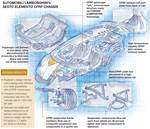Lamborghini developments highlight continued focus on composites
The Lamborghini, the purveyor of superb sportscars, has long been involved in composites, but has noted an increase in the lightweight materials’ application.
The Lamborghini composite LB744 “monofuselage.” The entire front structure is composite with aluminum alloys used for the rear. Photo Credit: Lamborghini
Two things are true: Composites are more expensive than materials including steel and aluminum, and Lamborghinis are more expensive than vehicles produced by other OEMs. So it shouldn’t be entirely surprising that Lamborghini uses, among other materials, carbon fiber composites — and works extensively on their deployment.
In fact, back in 2008, the company began using a technology it developed in-house, Forged Composites, to produce vehicular structures. Rather than using fabrics that look like woven carbon fiber (often used in faux form in interiors of vehicles that aren’t Lambos to provide the appearance of “technology”), the Forged Composites solution consists of short, chopped carbon fibers in a resin that are compression molded to create parts.
Lambo announced the development of the LB744 chassis for the Aventador replacement — which will be a plug-in hybrid — that uses a front structure made with Forged Composites, and a monolithic rocker ring made with carbon fiber-reinforced plastic (CFRP) that forms the supporting structure of the car and encloses and connects the tub, front firewall and A-pillar.
The chassis is deemed the “monofuselage.” According to Lambo, the front frame is 20% lighter than the aluminum structure used in the Aventador and has a 25% increase in torsional stiffness (40,000 Nm/deg).
However, the rear chassis is produced with high-strength aluminum alloys. The component uses two hollow castings in the rear dome area that integrate the shock towers and the powertrain suspension into a single component.
While the company doesn’t provide stats, it says there is “a significant reduction in weight, an increase in rigidity and”— here’s something you probably don’t associate with Lamborghini, but remember, at the end of the day, its cars are produced in a factory —“a substantial reduction in welding lines.”
With the LB744, Lamborghini is evidently getting even more committed to the use of carbon fiber in construction, saying that the monofuselage brings the company to “year zero,” from which there will be greater use.
What’s more, it has launched another production-oriented acronym “AIM”:
- Automation: The company will use more of it in production though “preserving traditional Lamborghini manufacturing, such as in the discipline of composites.”
- Integration: Combining what would otherwise be separate parts into one, using compression molding.
- Modularity: Using technologies that lend themselves to wide applicability in product build.
While Lamborghini is certainly no stranger to composites — and as such, it might seem as though it’s just another day in the factory in Sant’Agata Bolognese when it comes to using them — it is interesting to note that a few weeks before the reveal of the car it is emphasizing its structure.
Related Content
-
TPI manufactures all-composite Kenworth SuperTruck 2 cab
Class 8 diesel truck, now with a 20% lighter cab, achieves 136% freight efficiency improvement.
-
McLaren celebrates 10 years of the McLaren P1 hybrid hypercar
Lightweight carbon fiber construction, Formula 1-inspired aerodynamics and high-performance hybrid powertrain technologies hallmark this hybrid vehicle, serve as a springboard for new race cars.
-
Recycling hydrogen tanks to produce automotive structural components
Voith Composites and partners develop recycling solutions for hydrogen storage tanks and manufacturing methods to produce automotive parts from the recycled materials.

.jpg;width=70;height=70;mode=crop)















